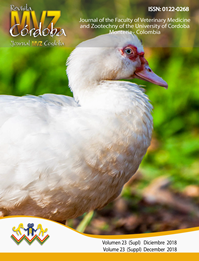Impacts of aquaculture on water nutrients and benthic macroinvertebrates of Lake Guamuez
Impactos de la acuicultura en los nutrientes del agua y macroinvertebrados bentónicos del Lago Guamuez
How to Cite
González Legarda, E. A., Burbano Gallardo, E., Aparicio Rengifo, R., Duque Nivia, G., & Imués Figueroa, M. A. (2018). Impacts of aquaculture on water nutrients and benthic macroinvertebrates of Lake Guamuez. Journal MVZ Cordoba, 23(S), 7035-7047. https://doi.org/10.21897/rmvz.1429
Dimensions
Show authors biography
Article visits 2660 | PDF visits
Downloads
Download data is not yet available.
- Food and Agriculture Organization of the United Nations (FAO). The state of world aquaculture and fisheries. Opportunities and Challenges [Internet]. Roma: FAO; 2016. [Citado sept 1 2017]. Disponible en: http://www.fao.org/3/a-i5555e.pdf
- Buschmann AH, Stead RA, Hernández MC, Pereda, SV., Paredes, J.E. Maldonado, M.A. Un análisis crítico sobre el uso de macroalgas como base para una acuicultura sustentable. Rev Chil Hist Nat. 2013; 86(3):251-264. https://doi.org/10.4067/S0716-078X2013000300003
- Parrado, Y. Historia de la acuicultura en Colombia. Rev AquaTIC. 2012; 37:60-77
- Lopez, M. y Madro-ero, S. Estado trófico de un lago tropical de alta monta-a: Caso Laguna de La Cocha. Cien Ing Neogranad. 2015; 25(2):21-42. https://doi.org/10.18359/rcin.1430
- Cabrera, W. LA COCHA: "Un Lago Andino en el Sur de Colombia". Soc Geog Col. 1970; 17(101):1-13
- Heerera M, Guerra C, Sarduy L, Garcia Y. y Martinez C. Diferentes métodos estadísticos para el análisis de variables discretas. Una aplicación en las ciencias agrícolas y técnicas. Rev Cie Téc Agr. 2012; 21(1):58-62.
- Correa J, Iral R, Rojas L. Estudio de potencia de pruebas de homogeneidad de varianza. Rev Col Est. 2006; 29(1):57-76.
- Carmona V, Carmona T. La Diversidad de los Analisis de Diversidad. Bioma. 2013; 14:20-28.
- Roldán G. Los macroinvertebrados como bioindicadores de la calidad del agua: cuatro décadas de desarrollo en Colombia y Latinoamérica. Rev Acad Col. 2016; 40(155):254-274.
- Roldán G. Fundamentos de Limnología Tropical. Colombia: Editorial Universidad de Antioquia; 1991.
- Vitoria I, Maraver F, Sánchez F, Valverde F. Contenido en nitratos de aguas de consumo público espa-olas. Rev Gac San. 2015; 29(3):217-220. https://doi.org/10.1016/j.gaceta.2014.12.007 PMid:25661464
- Velazco A, Calvario M, Pulido F, Acevedo S, Castro R, Román G. Problemática Ambiental de la Actividad Piscícola en el Estado de Hidalgo, México. Rev Acad Ing. 2012; 16(3):165-174.
- Torres, N. y Granadas, I. Estimación de los desperdicios generados por la producción de trucha arcoíris en el Lago de Tota, Colombia. Corpoica Cienc Tecnol Agrop. 2017; 18(2): 247-255. https://doi.org/10.21930/rcta.vol18_num2_art:631
- Carneiro C, Kelderman P, Irvine K. Assessment of phosphorus sediment-water exchange through water and mass budget in Passaúna Reservoir. Environmental Earth Sciences (Paraná State, Brazil). Environ Earth Sci. 2016; 75(7):564. https://doi.org/10.1007/s12665-016-5349-3
- Tomanova S, Polatera U. Patterns of benthic community traits in neotropical streams: relationship to mesoscale spatial variability. Fundamental Applied Limnology. 2007; 170:243-255. https://doi.org/10.1127/1863-9135/2007/0170-0243
- Guinard J, Ríos T, Bernal J. Diversidad y abundancia de macroinvertebrados acuáticos y calidad del agua de las cuencas alta y baja del río Gariché, provincia de Chiriqui, Panamá. Rev Gest Amb. 2013; 16(2):61-70.
- Baptista D, Buss B, Egler M, Giovanelli A, Silveira P, Nessimian J. A multimetric index based on benthic macroinvertebrates for evaluation of Atlantic Forest streams at Rio de Janeiro State, Brazil. Hydrobiologia. 2007; 575:83-94. https://doi.org/10.1007/s10750-006-0286-x
- Figueroa R, Palma A, Ruiz V, Niell X. Análisis comparativo de índices bióticos utilizados en la evaluación de la calidad de las aguas en un río mediterráneo de Chile: Río Chillan, VIII Región. Rev Chil Hist Nat 2007; 80(2):225-242. https://doi.org/10.4067/S0716-078X2007000200008
- Obando N, Bustamante C. Macroinvertebrados y algas perifiticas de la quebrada cajones, unidad de manejo de cuenca umc río espejo municipio de montenegro, quindío, Colombia. Rev Asoc Col. 2014; 26:133-144.
- Pla L. Biodiversidad: Inferencia basada en el índice de shannon y la riqueza. Interciencia. 2006; 31(8):583-590.
- Wronski T, Dusabe M, Apio A, Hausdorf B, Albrecht C. Biological assessment of water quality and biodiversity in Rwandan rivers draining into Lake Kivu. Aquat Ecol. 2015; 49(3):309–320. https://doi.org/10.1007/s10452-015-9525-4
- Reyes P, Torres J. Diversidad, distribución, riqueza y abundancia de condrictios de aguas profundas a través del archipiélago patagónico austral, Cabo de Hornos, Islas Diego Ramírez y el sector norte del paso Drake. Rev Biol Mar Oceanogr. 2009; 44(1):243-251. https://doi.org/10.4067/S0718-19572009000100025
- Cale-o Y, Rivera C, Ovalle H. Hábitos alimentarios de quironómidos (Diptera: Chironomidae) en lagos del páramo de Chingaza, Colombia. Rev Biol Trop. 2018; 66(1):136-148.
- Rossaro B, Lencioni V, Boggero A, Marziali L. Chironomids from Southern Alpine running waters. Ecology, Biogeography. Hydrobiologia. 2006; 562(1):231-246. https://doi.org/10.1007/s10750-005-1813-x
- Meza A, Rubio J, Dias L, Walteros J. Calidad de agua y composición de macroinvertebrados acuáticos en la subcuenca alta del Río Chinchiná. Caldasia. 2012; 34(2):443-456.
- Morelli E, Verdi A. Diversidad de macroinvertebrados acuáticos en cursos de agua dulce con vegetación ribere-a nativa de Uruguay. Rev Mex Bio. 2014; 85(4):1160-1170. https://doi.org/10.7550/rmb.45419
























